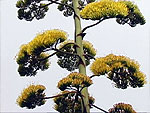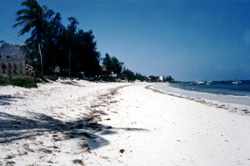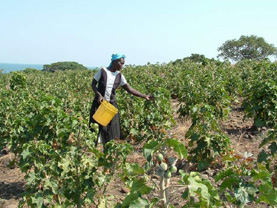Nyandiwa calls Italy: Italy answers!
- Home Page
- Harambee project
- About Kenya
- Where we are
- News
- Our Schools
- Harambee in Second Life
- Traditions
- Ebook & Tales
- Movies & Games
Republic of Kenya: Economy"Harambee" - "We work together with a common and disinterested effort " (Swahili exhortation to pull the nets of fishermen)
Kenya's economic growth is 5-6% / year with a bad distribution of income: the welfare of about 2% of the population is paid by the misery of many and 50% of the population lives below the poverty line.
Activities vary according to the three natural zones:
1) the semi-arid northeast region is sparsely populated and there is spread mainly cattle breeding;
2) the area of the midwestern highlands, land of volcanic fertilil Ivoirian agricultural activities;
3) the economy of the coastal plain on the Indian Ocean revolves around tourism. 80% of the population lives in these two regions. The Cities with more than 100,000 inhabitants are only 3: Nairobi, the capital, main port of Mombasa and Kisumu economic shores of Lake Victoria, which are connected by the only existing railway.
Agriculture & Breeding
 The Industrial crops of the colonial period, for export, have replaced subsistence crops and depleted the soil too used today agriculture in Kenya is affected by the climate and rainfall. Maize is the most widely grown cereal (covers 62% of territories), are widespread on the coasts to oil palm plantations and coconut, manioc and sorghum are grown in less fertile land, not completely satisfy the domestic needs. The plantations of foreign multinational companies producing for export coffee, tea, bananas, coconuts, sisal and pyrethrum, used for pesticides and insecticides to which Kenya is the world's largest exporter with about 8,000 tons per year. The local cooperatives who grow these products to sell abroad, foreign companies are limited by fixing prices and distribution, minimize the gains of the Africans.
The Industrial crops of the colonial period, for export, have replaced subsistence crops and depleted the soil too used today agriculture in Kenya is affected by the climate and rainfall. Maize is the most widely grown cereal (covers 62% of territories), are widespread on the coasts to oil palm plantations and coconut, manioc and sorghum are grown in less fertile land, not completely satisfy the domestic needs. The plantations of foreign multinational companies producing for export coffee, tea, bananas, coconuts, sisal and pyrethrum, used for pesticides and insecticides to which Kenya is the world's largest exporter with about 8,000 tons per year. The local cooperatives who grow these products to sell abroad, foreign companies are limited by fixing prices and distribution, minimize the gains of the Africans.
The breeding of cattle and sheep is widespread especially among the nomadic peoples like the Masai, but is hampered by long periods of drought that hit the majority of the country.
Industries & Tourism
 The industries are poorly developed, taking place mainly near the port of Mombasa and Nairobi under the control of European and Indopakistan. The Tourism is growing, accounting for 5% of Gross Domestic Product: arriving in Kenya each year more than 500,000 tourists attracted by the National Parks and beaches. Even the tourist facilities are the monopoly of foreign entrepreneurs and local people are only skilled and lower paid jobs. The energy produced by hydroelectric plants and Kiambati Turkwel is insufficient for domestic needs.
The industries are poorly developed, taking place mainly near the port of Mombasa and Nairobi under the control of European and Indopakistan. The Tourism is growing, accounting for 5% of Gross Domestic Product: arriving in Kenya each year more than 500,000 tourists attracted by the National Parks and beaches. Even the tourist facilities are the monopoly of foreign entrepreneurs and local people are only skilled and lower paid jobs. The energy produced by hydroelectric plants and Kiambati Turkwel is insufficient for domestic needs.
- Geophysics
- Climate of Kenya
- Natural Environment
- Economy
- Demographics
- Largest cities and Villages
- Music and Traditions
- South Nyanza
- About Kenya
